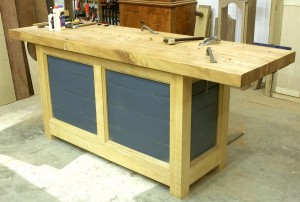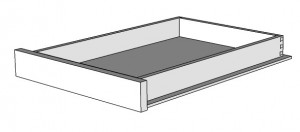We may receive a commission when you use our affiliate links. However, this does not impact our recommendations.
 In 2006, as I began my first round at Popular Woodworking Magazine (PWM), I was told I had to build a workbench. Even with then editor Christopher Schwarz chest deep in workbench publications, it wasn’t a mandate as much as it was a necessity. In the PWM shop, there was no usable bench empty and awaiting a woodworker.
In 2006, as I began my first round at Popular Woodworking Magazine (PWM), I was told I had to build a workbench. Even with then editor Christopher Schwarz chest deep in workbench publications, it wasn’t a mandate as much as it was a necessity. In the PWM shop, there was no usable bench empty and awaiting a woodworker.
I did not need to look far for a workbench to copy as I was always interested in a Shaker-designed bench – loved the painted bases in strong, bold colors. I built my bench which was published in our December 2007 issue (#166). Need a copy, click here, or if you just need the article, click here.
As I return to PWM, I find myself in an identical position – I’m not bringing my Shaker bench back because I use it in my home shop. I have, in turn, decided to build another bench. With this bench I plan to have a simple frame, a weighty top and a stack of drawer squeezed into the center. It’s the drawers on which I want to focus.
After my Shaker workbench was published, I was asked to write a page on what I would change if I were to build that bench a second time. The only change I had at the time concerned the drawers, which were way too deep to be best used. I could divide those drawers from top to bottom, but I am not found of having to slide drawer tills as I dig for tools.
 In my SketchUp model of my next bench, there are ten drawers that are not nearly as deep. Ten drawers have a lot of hand-cut dovetails, so I plan to dig into different drawer construction methods before choosing how to build my drawers. As of now, I plan to study spline construction, dowel-pinned joints, sliding dovetails, dado & rabbet joinery and box joints.
In my SketchUp model of my next bench, there are ten drawers that are not nearly as deep. Ten drawers have a lot of hand-cut dovetails, so I plan to dig into different drawer construction methods before choosing how to build my drawers. As of now, I plan to study spline construction, dowel-pinned joints, sliding dovetails, dado & rabbet joinery and box joints.
I’m not looking for the best joint, or the easiest joint. I’m looking for a solid designed joint that does what it needs to do. So If you have suggestions that I may have forgotten or skipped, I am open to your ideas.
—Glen D. Huey
Looking for more information on workbenches? Checkout these products: Building Workbenches, 24-hour Workbench and Moxon’s Bench Vise.
Here are some supplies and tools we find essential in our everyday work around the shop. We may receive a commission from sales referred by our links; however, we have carefully selected these products for their usefulness and quality.








Hi Glen,
In 1983, before I knew how to do it any fancier, I built my kitchen cabinets drawers using drawer joints cut on the table saw in AB fir plywood. Though they’re not fancy, they were quick to build and have held up to daily sliding in an out for the past 30 years with no apparent damage to any of them.
But here’s a question for you: I built a Roubo workbench last summer with a 4 1/2″- thick top, and also would like to fit drawers in it. But how do you do it so they don’t obstruct the hold-fast holes? I love the Gramercy Holdfasts, but they hang down 4 3/4″ below the top, right into where the drawers would be. Do you not use holdfasts, or have you come up with a solution?
Thanks
When I built mine I later decided to add six drawers with full extension glides. I didn’t want fancy just quick so I used pocket screws for the corners which I also glued and they work great. KISS
Glenn, good to have you back at PW. A couple of years ago at WIA, you did a seminar on drawers with one table saw setup. Those drawers are very strong, very quick, and easy to make, and will do fine for a workbench. I have used it over and over again in my shop, and even for some quick throw together stuff for other people. One modification I made was to use 1/2″ baltic birch for the bottoms, as well as the sides. Then, you got yourself a bygolly really strong drawer. Again, welcome back.
Home Depot. Modular storage drawers.
This is for go, not for show — except for publication I suppose. Sliding dovetails will be quick and strong for drawers up to 12″ high. With a bit of planning one set up and all the drawers can be run at once. Build a grid frame out of 1/2″ ply with spaces for each drawer. Slide that frame as a unit into the space under the top. Allow the drawers to slide on/within that frame (no drawer slides required) and allow the finished and waxed drawers (24″ long) to slide through the frame to open either side of the bench. Very convenient, especially if some pointy thing wedges itself into the interior of the frame. I made three drawers at the top 1 3/4″ high for pencils, magnifiers, mini flashlights, markers and drafting tools, etc., but I regret not making them 2 1/4″ high (top of drawer to top of carpeted interior). BTW even after a decade of everyday use, if storing several big planes in lower 10″ high drawers a sliding dovetail will be plenty strong for a lifetime.
Glen, why not use a different joint for each drawer?
I agree with b33tl3; a drawer lock joint is a good choice. It gives you pretty much everything: mechanical strength, easy to make, and you can make the drawer you have shown. In the back, use the joint as shown in b33’s link. In the front, use the joint shown as here: http://rabbitwoodworks.com/images/Joinery/drawer-lock-joints.jpg
For a belt and suspenders approach, drill and dowel the joint after assembly.
Nice design in general. I like the shaker style-anything.
However, I would raise the bottom stretchers. Leave 4 inches between floor and bottom of strechers on all sides.
This gives you room for your feet to fit under it. (and, less effort for old guys like me to bend over and reach the bottom shelf). Make up the space by reducing the depth of drawer position 1&2…I prefer equidistance drawer depths here, good for hand tools such as chisels & dogs. (Golden ratio doesn’t help your bench work better !).
Hi Glen,
Your are right to go with shallow drawers. I have a stack of these near my bench and they are great for chisels, scissors, pliers, measuring, drawing, and model making tools. Mine are plywood with box joints and glued-on fronts with bolt-through handles, the bases sliding in slots like the one in your drawing. At the bench I use an old fruit crate full of different kinds of vise and clamp that add mass to the bench (see http://www.workbenchdesign.net/walkaround/walkaround.html). If I were building a bench like the Shaker one, I would want shallow drawers in it too. However I also recommend making sure you can add a detachable mini top to it like Jonas Jensen’s. I made one from 2 by structural hem fir, and it is the most useful item I have ever made for a workbench.
Glen,
I am pretty certain you have seen the Shaker bench from Benchcrafted, at http://benchcrafted.blogspot.com/search/label/Shaker%20Bench.
Or the one Ron Brese built (2 videos):
Part 1:
http://abouna.smugmug.com/Commercial-Work/Benchcrafted-Videos/11365604_W9b4u#!i=798386399&k=Bgt93
and
Part 2:
http://abouna.smugmug.com/Commercial-Work/Benchcrafted-Videos/11365604_W9b4u#!i=798861782&k=sDfJv
I believe that any of these designs will work very well.
Joinery:
I agree – too may dovetails. But I know your expertise with the router 🙂
I would use sliding dovetails for the drawer fronts, and either box joints or dovetails for the backs.
Here’s to the new bench!
— Al Navas
I built Cecil Braden’s interlocking plywood workbench, adding a bank of drawers, some hardwood trim, and retractable casters. The fact that it can be readily dismantled is another plus, as I prepare to move. Low tech, affordable, and very functional.
I ripped off Robert Whitley’s bench drawer design which means I can access them from either side of the bench. They also act as board jacks.
I noticed that the said Shaker Workbench was featured in the December 2007 issue, not 2006, as stated. I only mention it, in case someone starts looking for their issue of the magazine.
Glen,
There have been a lot of new developments over the past few years re. vises, clamp mechanisms, and other workbench hardware. Benchcrfated and Veritas comes to mind. It might be useful to consider which of these have panned out to be truly breakthroughs and which might not be so much.
How about using a 45 deg. lock miter router bit? Once the setup is done, you can run every front, side and back without a change. Quick, easy, clean….unless you prefer to be able to see the joint construction from the side when a drawer is open….
You may wind up taking a hybrid approach. I seem to remember you wrote a piece on dovetailing with a router table. And it seems I remember that you could set it up for any number of tails at each corner. I would like to see that again.
I consider it nice to be able to do handtool work for the knowledge of how tools work on wood. But once you have that knowledge, and you have it in spades, just remember that neither of the Hall brothers (the other half of Greene and Greene) didn’t exactly turn their noses up at the latest and greatest for their time.
What’s also in the back of my mind was a chapter out of Khalil Gibran’s Jesus, the Son of Man, where a remodeling client shared his praises of Jesus’ framework where the wood was finished quite smoothly. Given that the plane first came about during the first century CE …..
Just sayin’
I like having a dead man on the front like the BenchCrafted design has:http://benchcrafted.com/shaker.html
I often use the g’night joint for shop furniture:
Glue it, Nail it. I Get Home in Time.
Then again, I have no woodworking reputation to maintain. 🙂
Glen–first, glad to hear you’re back at PW.
Don’t know if this bench is going up against a wall or if it’s going to sit in the middle of the room. If the latter, have you considered having drawers on both sides of the bench?
I now have a bench in the middle of my shop floor and find that I use the back side of the top for power tools and the front side of the bench for hand tools. Some of that is due to shop orientation and some of it is due to practical concerns (like not wanting to run my router or track saw near my face vise).
My bench drawers (almost all drawers in my shop, actually) are box joints. Simple, effective, quick.
A rabbetted corner with a glued on triangle in the corner could be a solution.
But I would prefer the dovetails. If the drawers are shallow, you can just make one dovetail in each corner. Then it wouldn’t be such a big job.
What about a simple Drawer lock joint on the boxes with a nice face. The work bench is a tool so nothing fancy is required. http://www.popularwoodworking.com/articleindex/power-tool-joinery-lock-joint-holds-drawers-tight
I always liked the idea of attaching drawer sides to the front with sliding dovetails, though I never tried it myself. But I’m guessing the operation would go fairly easily after the initial set-up.